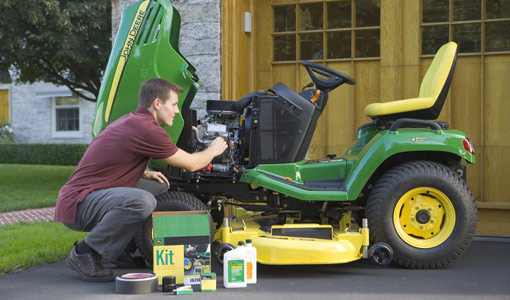
via TodaysHomeowner
By Melody Boggs on 11 April 2014
Atlanta–Warmer weather brings with it a myriad of happy things—family picnics, sundresses, a new sports season, beach trips—but it also means homeowners must perform constant yard maintenance. Grass grows slowly at the beginning of spring as it awakens from its dormant winter state, but you’ll be surprised how quickly grass can make your yard appear unruly. What’s more, grass growth speeds up the closer to summer we get, and you’ll need to be prepared. Speaking of which, when was the last time you performed any maintenance on your lawn mower? This expensive tool is crucial to controlling grass growth. Any mower problem you have can set you back days on your lawn maintenance routine and can also cost you some steep prices to repair or replace it. Look to our new list of maintenance tips to help you avoid these potential problems in the future. 1. Keep the owner’s manual close. For your particular mower, this will be the most accurate guide you have on how to care for your mower properly so that it will last as long as possible. Manufacturers will want to keep their customers happy, so that they will be likely to buy another model when the time comes.
2. Drain out leftover gasoline at the end of every mowing season. Run the motor until the engine runs out of gas and then drain the engine oil into an appropriate container for recycling. Old gas is often the cause of why a motor won’t start, so eliminate the problem early on.
3. Check the oil. Your manual will guide you on the right type of oil you should use. Especially look to see if your oil is carrying debris or has taken on a dark black color, which is a sign that your oil has been contaminated. When that happens, drain your oil safely as recommended above and replace it immediately.
4. Change the spark plug. This should be done once a year for best results, and luckily the cost for spark plugs is pretty inexpensive. Simply disconnect the spark plug wire and use a wrench or pliers to remove the existing plug. Screw in the new plug, but don’t do so too tightly since that could cause start-up problems for the motor.
5. Sharpen the blade. With a dull blade, you’re liable to shred the grass instead of cut it, which will cause the grass to brown and your lawn as a whole to look unhealthy. Disease can also enter the grass if it’s not cut evenly. If you’re experienced, then use a vice and metal file to sharpen the blade; if not, please go to a mower repair shop. Blade sharpening is often included in a general mower tune-up and will only cost a small fee.
6. Clean out the undercarriage. Grass, rocks, and other debris get caught and can often clog up your mower’s discharge chute. Before starting, disconnect your spark plug and make sure your gas tank is empty, then use a wire brush and a hose to get ride of all the debris. This may also be a good time to give the rest of your mower a good cleaning.
7. Check for any loose or worn parts. Screws should be tightened, belts and chain drivers checked, and grease fittings thoroughly greased. Replace any parts that are worn down or not functioning properly before you begin cutting your grass.
8. Check the air filter. Air filters should be cleaned or replaced twice a year, depending on your needs. Paper filters should be replaced whenever they get too dirty, while plastic ones can be washed with soapy water. Coat the filter with two tablespoons of motor oil to keep the filter working properly. This will keep the mower from operating under added stress due to any clogs and will burn gas more efficiently.
9. Check your tires. If you have a riding lawn mower, this is especially important. Make sure your tires have enough air pressure and that no tire is flat. A problem with your tire in the middle of a cut can be inconvenient at best and dangerous at worst. Check your tire brand to determine what the air pressure (PSI) maximum is before you pump up the tire. You don’t want to accidentally cause it to burst!
As always, if you do not feel comfortable performing these maintenance tips yourself, enlisting the help of a landscaping or lawn mower expert is always an option.
#1 by Richard Hayden on May 2, 2014 - 8:08 am
Thank you for posting this article Melody Boggs, information provided here are really helpful.
LikeLike